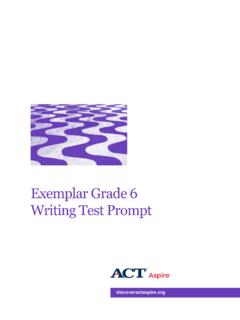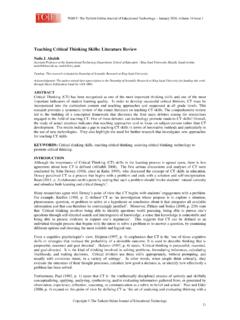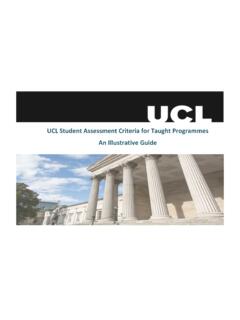Transcription of ENGLISH AS A SECOND LANGUAGE (ESL) A 9-12 Curriculum …
1 ENGLISH AS A SECOND LANGUAGE (ESL). A 9-12 Curriculum Guide Atlantic City Schools Atlantic City, NJ. 2014. Atlantic City Board of Education 2013-2014. Patricia Bailey, President Edward Cooper, Vice-President Ruth Byard John Devlin Kirk Dooley Walter Johnson Nynell Langford Shay Steele Fariyd Holmes Kim Bassford Steve Bonanni Donna L. Haye, Superintendent of Schools Sherry Yahn, Assistant Superintendent, Curriculum and Instruction Barry Caldwell, Assistant Superintendent, General Operations ACKNOWLEDGEMENTS. A special task force representing the administrators and teachers of the Atlantic City Schools produced this guide. Their names and schools are listed below. We wish to acknowledge our thanks to all of them for the excellent work they have done in producing a guide that represents the current pedagogy within the teaching of ENGLISH as a SECOND LANGUAGE and the special needs of the teachers and the students in the school system.
2 Donna L. Haye Superintendent of Schools Sherry Yahn Assistant Superintendent, Curriculum and Instruction BILINGUAL/ ENGLISH AS A SECOND LANGUAGE . Curriculum TASK FORCE. Mark Deebold Atlantic City High School-2014. MaryAnn Mena Bilingual/ESL/World Languages-2014. Lourdes L. Vidal-Turner, Supervisor of Bilingual, ESL and World Languages-2002-2014. TABLE OF CONTENTS. Philosophy of the Curriculum Section 1. The 9-12 Program of Study Section 2. ESL Newcomer * Curriculum Overview * Syllabus * Unit Plans * writing Portfolio/Benchmarks * Ancillary Materials * PARCC Practice * Rosetta Stone Pacing Guide ESL One * Curriculum Overview * Syllabus * Unit Plans * writing Portfolio/Benchmarks * PARCC Practice * Rosetta Stone Pacing Guide ESL Two * Curriculum Overview * Syllabus * Unit Plans * writing Portfolio/Benchmarks * Lesson Plans * Ancillary Materials (World Literature).
3 * Rosetta Stone Pacing Guide * PARCC Practice ESL Three * Curriculum Overview * Syllabus *Quarterly Benchmarks * Unit Plans * Sample Lessons * PARCC Practice ESL Four * Curriculum Overview * Syllabus * Quarterly Benchmarks * Unit Plans * Sample Lessons * PARCC Practice Appendix A The ENGLISH LANGUAGE Proficiency Standards Section 3. Appendix B writing and Oral Presentation Rubrics Section 4. Appendix C Linguistic Expectations of ESL Students in Content Clases Section 5. Appendix D ACCESS for ELLS Section 6. Appendix E Sample Persuasive writing Unit (HSPAT) Section 7. Philosophy of the Curriculum The ENGLISH as a SECOND LANGUAGE Curriculum is not a stand-alone document. It is an integrated Curriculum that is aligned to prepare ENGLISH LANGUAGE learners (ELLs) to meet the ENGLISH LANGUAGE proficiency standards, the common core state standards (CCSS), and the World-Class Instructional Design and Assessment ENGLISH LANGUAGE Development (WIDA.)
4 ELD) standards. In order to accomplish this, the ESL Curriculum incorporates the development of LANGUAGE and literacy skills for use across all subject areas. Rigor and relevance is introduced in the form of discourse, technological applications, and sociocultural contexts for LANGUAGE use involving interaction between the student and the LANGUAGE environment. Although the listening and speaking skills are stressed for students at the lowest levels of ENGLISH LANGUAGE acquisition, reading and writing should be included from the beginning. Specifically, efforts are made at the start to connect listening and speaking at all levels. These skills should be taught together with reading assignments related to, or coming out of writing tasks whenever possible. ESL writing instruction begins early on to support the development of increased vocabulary and improved thinking skills.
5 The writing is used as concrete evidence of individual achievement, and serves to enrich comprehension of both written and spoken LANGUAGE at all levels. The instructional model used by sheltered and ESL staff is Sheltered Instruction Observation Protocol (SIOP). This is a research-based and validated instructional model that has proven effective in addressing the academic needs of ENGLISH learners throughout the United States. The SIOP Model consists of eight interrelated components: Lesson Preparation Building Background Comprehensible Input Strategies Interaction Practice/Application Lesson Delivery Review & Assessment Using instructional strategies connected to each of these components ESL instruction is designed to deliver lessons that address the academic and linguistic needs of ESL students.
6 Differentiation addresses the prominent and competing values of excellence, efficiency, equity, and choice as fluent factors of the Curriculum . The operational goal of the grades 9-12 ENGLISH as a SECOND LANGUAGE Curriculum is to foster higher levels of cognition and deep subject matter understanding, to assist the transference of learning via differentiated strategies, and to present relevant performance based projects that lead to an authentic engagement in ENGLISH LANGUAGE usage. Curricular Assessment The WIDA standards can be applied to the Common Core State Standards in LANGUAGE arts. They are designed so that students will graduate with a strong methodology for listening, speaking, reading and writing in ENGLISH as a SECOND LANGUAGE . The ENGLISH as a SECOND LANGUAGE Curriculum also supports and perpetuates a dynamic for ENGLISH LANGUAGE learners to talk about the cultural, historical, political, and social context of their native countries.
7 Cultural competency and inclusion of the contributions of immigrants enhances the philosophy of the Curriculum which rests on a platform of essentialism in keeping with the fundamental approach to teaching a foreign LANGUAGE by listening, speaking, reading and writing ENGLISH ; but it is also progressive enough to encompass a world-view and utilize the students and their families to develop a greater perspective of what it is to be a member of American society. The Curriculum remains in need of flow and flex as each new wave of immigrants pass through our doors. Our students must be fully equipped to immerse themselves in American society as a result of their experience in the ESL program at Atlantic City High School. We envision their exit from the program and subsequent graduation as a demonstration of their ability to genuinely participate in conversations that involve the Atlantic City High School experience and society at large.
8 That type of ideology is borne out through classroom activities. The ESL classroom is special because the cultural capital in the room is so rich. Each student is recognized for who they are which in turn brings about a level of acceptance. Everyone contributes to the difference in the academic environment. The same is true for any situation in which the distinction exists because of the similarity within the group. They all speak ENGLISH as a SECOND or other LANGUAGE and their approach to learning is manifested in the output they contribute. Consequently, classroom tasks can flourish if the targeted objective reflects their presence in the classroom as well as the society in which they currently live. In other words, ESL educators should continue to look for opportunities to do things their way, not the cut and dried approach of learning to do it our way.
9 The National Association of State Boards of Education (2002) offers the following key recommendations for culturally competent schools: Use high academic standards as the basis of instruction for all students. Adopt a Curriculum that fosters cultural competency. Demonstrate respect for students' identities and welcome a diverse community to participate in schools. Acknowledge students' diverse learning styles. Ensure qualified personnel for all students. Provide extra help for schools and students who need it. Atlantic City High School follows the protocols for a school that demonstrates cultural competency. The following researched material is offered as a reference for establishing a Curriculum that addresses the needs of preparing our ESL students for the demands of 21st century learning.
10 Please see the wiki spaces page and click pages and files in order to see the power point presentation regarding types of Curriculum models, articles and videos on cultural competence, and frameworks for understanding by design. Ideas for infusing technology into classes are found in the right margin. Go to: A Curriculum review for the ESL program at Atlantic City High School includes the following models in an effort to determine a direction in which to proceed. (See left and following page) One suggestion is for a whole faculty study group (WFSG) that meets regularly throughout the year to determine the curricular needs of our students. This group could investigate the possibility of incorporating integrative thematic instruction which would enhance the teaching /learning process, through lessons that link the LANGUAGE and serve to increase knowledge of the subjects studied.




